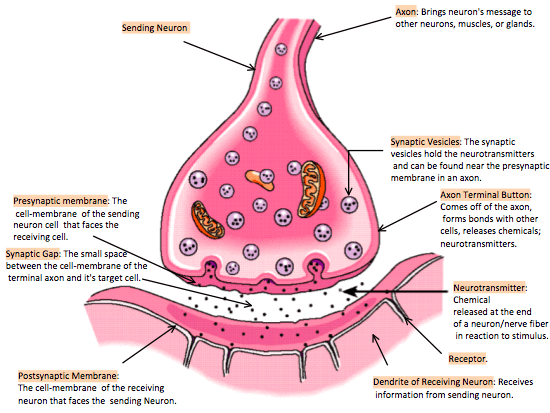Neuron Structure
A Neuron is a type of cell that is essential to the nervous system. It’s function is to cary electrical signals/impulses throughout the body. Neurons are made up of many parts they contain Dendrites which receive the information from the body and bring it to the cell body. The cell body is responsible for providing immediate life-support and to fulfil the essential functions. The axon spreads the neuron’s message to other neurons, muscles or glands by a structure referred to as the terminal buttons or presynaptic axon terminal which comes off of the axon to form bonds with other cells or muscle fibres. The terminal buttons also release neurotransmitters. A neurotransmitter is a chemical released during action potential diffused across the synapse junction in order to transfer nerve impulses from the cell fibre, to other neurons, muscles, or glands.
The Motor Neuron
The motor neuron is a nerve cell which is part of pathway formed for impulses to pass from the nervous system or a ganglion to muscles or glands. These impulses trigger movement – which can be received from the information brought in by sensory nerves.
The Sensory Neuron
The sensory neuron connects sense organs to the nervous system. The sensory neuron receives information from the outside world and transfers it through the nervous system. Sensory neurons react to external stimuli and convert it into internal impulses that they can then export to motor neurons through terminal buttons and synaptic endings to activate movement.
The Interneuron
The interneurons receive and interpret information from other neurons for example: the sensory neurons. Then, they must transfer this information to the motor-neuron to activate movement.
Neuron Function
How an action potential moves along the neuron fibre?
The process of action potential can be broken down into four steps. The purpose of action potential is to transfer electrical signals/impulses from one cell to another.
The first step is resting potential when the axon is not stimulated or at rest/polarized. The fluid inside the axon is more negative then the fluid on the outside. This is because of the axons membrane which is a semi-permeable membrane meaning that it allows certain substances to pass but blocks others. There is also a sodium-potassium pump, which pumps potassium in and out of the axon. The Sodium which is positive is found on the outside. The charge of the axon is -70 in relation to the outside.
The second step is depolarization – which occurs with a significant stimulation. Positive sodium ions rush into the opening in the first part of the axon and the additional ions charge the previously charged negative ions into positive ions. At this point the fluid is charged at +30 relative to the outside.
The third step is repolarization. The axon membrane of the first part of the axon that has already opened up, opens up again and potassium flows out. The first section repolarizes and is now resting again. Making the charge around -75. (Not completely back to resting potential)
The fourth and final step is the refractory/ recovery period, when potassium goes back to being pumped in and out and inside is more negative at -70.
Synapse Structure
Above photo from one-note. Structures and definitions added by me.
Synapse Function
How a signal is sent from axon of sending neuron to dendrite of receiving neuron.
- Action potential reaches the axon terminal and depolarizes the membrane.
- Ca 2+ gates open and it flows in.
- Ca 2+ that flows in causes the synaptic vesicles to release their neurotransmitters/chemical released at the end of neuron in reaction to stimulus.
- Neurotransmitter attaches on to the receptors on the terminal cell and positive ions flow in.
- The Neurotransmitters are stored in the synaptic vesicles.
- The base of the neurotransmitter are recycled.
- The action potential attains action terminal.
- Synaptic Vesicles/Neurotransmitters are released into the gap.
- Neurotransmitters diffuse through the synaptic gap on the initial cell and attach to the receiving cells.
The purpose is for one neuron to send a message to another neuron, in order for it to occur an action potential has to cause the the presynaptic neuron/initial neuron to release neurotransmitters.
How the receiving neuron “determines” whether or not to send its own action potential.
The receiving neuron determines whether or not to send its own action potential based on whether the inside of the receiving axon is more positive or negative. When the neurotransmitters bind to the receptors on the receiving cell it either triggers an opening or closing in the channels. This may cause one of two differences in the membrane potential. It can be either excitatory postsynaptic potential, or inhibitory post-synaptic potential. If it’s excitatory postsynaptic potential there is a more probable chance that the receiving neuron would send it’s own action potential because it leads to depolarization starting the cycle. If it’s inhibitory post-synaptic potential then it does the opposite to the membrane making it remain negative on the inside. Inhibitory post-synaptic are crucial to counteracting the excitatory postsynaptic potentials.




